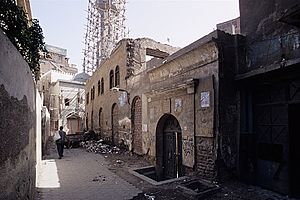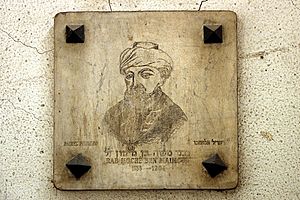Maimonides Synagogue facts for kids
The Maimonides Synagogue (Hebrew: בית כנסת הרמב"ם, translit: Bet Knesset ha-Rambam; Arabic: كنيس ابن ميمون), also known as the Rav Moshe Synagogue, is a very old synagogue in Cairo, Egypt. A synagogue has been on this spot since the 10th century. It was later named after the famous Jewish philosopher, rabbi, and doctor Maimonides, who arrived there around 1168. Many people believe Maimonides' original tomb is inside the building. In March 2010, the Egyptian government finished restoring the building, which was built in the late 1800s.
Contents
Early History of the Synagogue
A synagogue was already here about 200 years before Maimonides came to Egypt around 1168. He had to leave Córdoba, Spain, because of a group called the Almohads. The Almohads took over Córdoba in 1148. They gave the Jewish community a choice: change to Islam, face death, or leave. Maimonides' family, like most other Jews, chose to leave.
After living in southern Spain for ten years, they moved to Morocco. Finally, they settled in Fustat, Egypt, around 1168. In Egypt, Maimonides became very well known. He even became a doctor for Qadi al-Fadil, who worked for Saladin. Maimonides studied and worked in a special school called a yeshiva that was connected to the small synagogue.
The synagogue and yeshiva are in Harat al-Yahud, the Jewish quarter of medieval Cairo. You can only reach them by walking. In Maimonides' time, most people living in this area were Jewish.
After Maimonides died in Fustat on December 12, 1204, people believe he was buried at the synagogue for a short time. Then, he was moved to Tiberias. Some traditions say his bones were placed for a week in a small shrine where he used to study and help people. However, some believe his bones never actually left Egypt.
Rebuilding in the 19th Century
In the 1800s, a new synagogue was built on the same spot. It was named in honor of Maimonides.
The Synagogue in the 20th Century
Life for Egypt's Jews became very difficult in the mid-1900s. People in Arab countries felt a stronger sense of Arab identity. Also, there was more tension between Jews and Arabs after the 1948 Arab-Israeli War. Later, events like the 1956 Suez War made things worse.
The government put limits on foreign businesses, which greatly affected the Jewish community. Thousands of Jewish residents were forced to leave the country after the 1956 war. Many more left because of the difficult social and economic conditions. Egypt's Jewish population eventually dropped from 80,000 to fewer than 100 people.
With only about 30 Jews left in Cairo, mostly older women, the synagogue closed. It almost fell apart due to underground water and earthquakes. The ceiling of the building collapsed in 1992. The area around the synagogue was also filled with garbage.
Zahi Hawass, who was in charge of ancient sites, said the synagogue was last used in 1960. After that, it was allowed to "crumble." Even though it was declared an ancient site in 1986, its condition got even worse by 2005. A holy ark with a broken door was in the small courtyard, covered with debris. The ark's Star of David was still there, but it was barely hanging on.
Restoration in the 21st Century
In June 2009, the Egyptian government started a project to restore the synagogue. Zahi Hawass showed the plans in August 2009. This restoration project cost $2 million and took 18 months. The Egyptian government paid for the work on the Rav Moshe synagogue, which is in an area of Cairo once called "the neighborhood of the Jews."
The restoration work was finished in March 2010. Besides Maimonides' tomb, the synagogue has two areas for prayer and rituals. One of these areas was for women.
Among the synagogue's special items is a Bible that some believe was written by Maimonides himself. The former Israeli ambassador to Egypt, Zvi Mazel, said the results were amazing. He noted that the original colors were almost perfectly restored.
Legends and Traditions
According to a story told by Joseph ben Isaac Sambari, a Jewish-Egyptian writer from the 1600s, something interesting happened when Maimonides' body was being carried to the Sea of Galilee for burial. The people carrying his body accidentally left one of his toes behind in the synagogue. At that time, the synagogue was called the synagogue of Western (Tunisian) Jews.
Later, one of the people who carried the body had a dream. In the dream, a wise man from Egypt reminded him about the forgotten toe. The toe was later found and buried next to Maimonides' body.
The synagogue and its school (yeshiva) have long been thought to have amazing healing powers. Until the Egyptian government stopped the practice in 1948, the local Jewish community used the synagogue as a place for healing. A sick person would be left to sleep in a special underground room. People hoped that the person would dream of Maimonides and get better.
See also
 In Spanish: Sinagoga Maimónides para niños
In Spanish: Sinagoga Maimónides para niños




